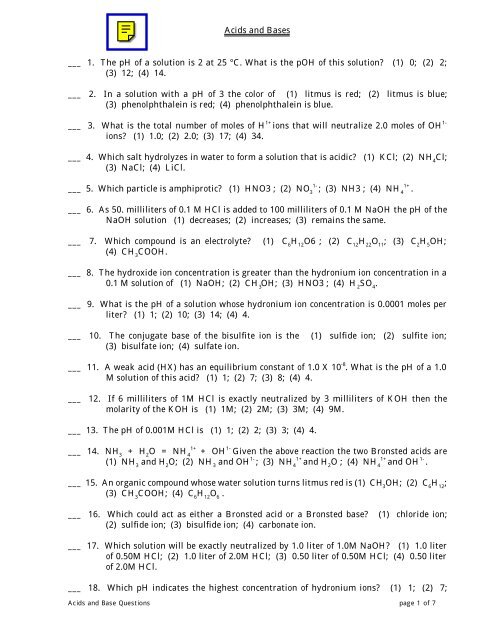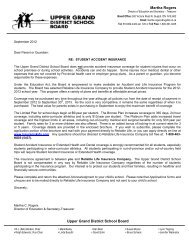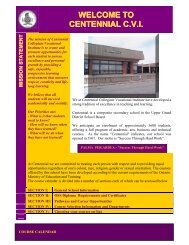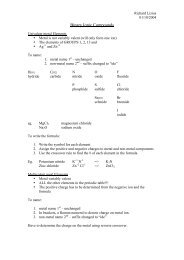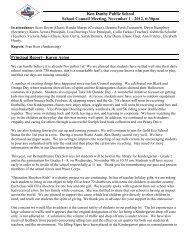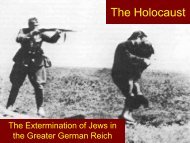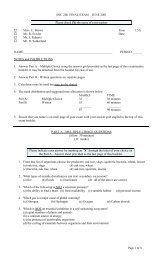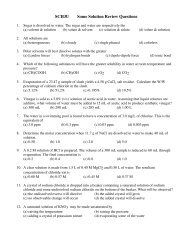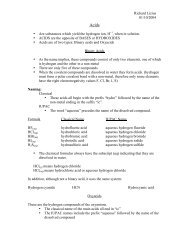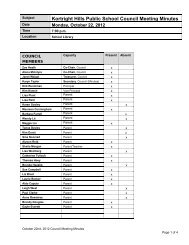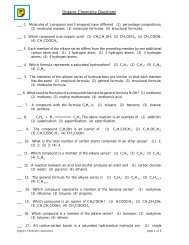Acids and Bases ___ 1. The pH of a solution is 2 at 25 °C. What is ...
Acids and Bases ___ 1. The pH of a solution is 2 at 25 °C. What is ...
Acids and Bases ___ 1. The pH of a solution is 2 at 25 °C. What is ...
You also want an ePaper? Increase the reach of your titles
YUMPU automatically turns print PDFs into web optimized ePapers that Google loves.
<strong>Acids</strong> <strong>and</strong> <strong>Bases</strong><br />
___ <strong>1.</strong> <strong>The</strong> <strong>pH</strong> <strong>of</strong> a <strong>solution</strong> <strong>is</strong> 2 <strong>at</strong> <strong>25</strong> °C. Wh<strong>at</strong> <strong>is</strong> the pOH <strong>of</strong> th<strong>is</strong> <strong>solution</strong>? (1) 0; (2) 2;<br />
(3) 12; (4) 14.<br />
___ 2. In a <strong>solution</strong> with a <strong>pH</strong> <strong>of</strong> 3 the color <strong>of</strong> (1) litmus <strong>is</strong> red; (2) litmus <strong>is</strong> blue;<br />
(3) phenolphthalein <strong>is</strong> red; (4) phenolphthalein <strong>is</strong> blue.<br />
___ 3. Wh<strong>at</strong> <strong>is</strong> the total number <strong>of</strong> moles <strong>of</strong> H 1+ ions th<strong>at</strong> will neutralize 2.0 moles <strong>of</strong> OH 1-<br />
ions? (1) <strong>1.</strong>0; (2) 2.0; (3) 17; (4) 34.<br />
___ 4. Which salt hydrolyzes in w<strong>at</strong>er to form a <strong>solution</strong> th<strong>at</strong> <strong>is</strong> acidic? (1) KCl; (2) NH 4<br />
Cl;<br />
(3) NaCl; (4) LiCl.<br />
___ 5. Which particle <strong>is</strong> amphiprotic? (1) HNO3 ; (2) NO 3<br />
1-<br />
; (3) NH3 ; (4) NH 4<br />
1+<br />
.<br />
___ 6. As 50. milliliters <strong>of</strong> 0.1 M HCl <strong>is</strong> added to 100 milliliters <strong>of</strong> 0.1 M NaOH the <strong>pH</strong> <strong>of</strong> the<br />
NaOH <strong>solution</strong> (1) decreases; (2) increases; (3) remains the same.<br />
___ 7. Which compound <strong>is</strong> an electrolyte?<br />
(4) CH 3<br />
COOH.<br />
(1) C 6<br />
H 12<br />
O6 ; (2) C 12<br />
H 22<br />
O 11<br />
; (3) C 2<br />
H 5<br />
OH;<br />
___ 8. <strong>The</strong> hydroxide ion concentr<strong>at</strong>ion <strong>is</strong> gre<strong>at</strong>er than the hydronium ion concentr<strong>at</strong>ion in a<br />
0.1 M <strong>solution</strong> <strong>of</strong> (1) NaOH; (2) CH 3<br />
OH; (3) HNO3 ; (4) H 2<br />
SO 4<br />
.<br />
___ 9. Wh<strong>at</strong> <strong>is</strong> the <strong>pH</strong> <strong>of</strong> a <strong>solution</strong> whose hydronium ion concentr<strong>at</strong>ion <strong>is</strong> 0.0001 moles per<br />
liter? (1) 1; (2) 10; (3) 14; (4) 4.<br />
___ 10. <strong>The</strong> conjug<strong>at</strong>e base <strong>of</strong> the b<strong>is</strong>ulfite ion <strong>is</strong> the<br />
(3) b<strong>is</strong>ulf<strong>at</strong>e ion; (4) sulf<strong>at</strong>e ion.<br />
(1) sulfide ion; (2) sulfite ion;<br />
___ 1<strong>1.</strong> A weak acid (HX) has an equilibrium constant <strong>of</strong> <strong>1.</strong>0 X 10 -8 . Wh<strong>at</strong> <strong>is</strong> the <strong>pH</strong> <strong>of</strong> a <strong>1.</strong>0<br />
M <strong>solution</strong> <strong>of</strong> th<strong>is</strong> acid? (1) 1; (2) 7; (3) 8; (4) 4.<br />
___ 12. If 6 milliliters <strong>of</strong> 1M HCl <strong>is</strong> exactly neutralized by 3 milliliters <strong>of</strong> KOH then the<br />
molarity <strong>of</strong> the KOH <strong>is</strong> (1) 1M; (2) 2M; (3) 3M; (4) 9M.<br />
___ 13. <strong>The</strong> <strong>pH</strong> <strong>of</strong> 0.001M HCl <strong>is</strong> (1) 1; (2) 2; (3) 3; (4) 4.<br />
1+<br />
___ 14. NH 3<br />
+ H 2<br />
O = NH 4<br />
+ OH 1- Given the above reaction the two Bronsted acids are<br />
(1) NH 3<br />
<strong>and</strong> H 2<br />
O; (2) NH 3<br />
<strong>and</strong> OH 1- 1+ 1+<br />
; (3) NH 4<br />
<strong>and</strong> H 2<br />
O ; (4) NH 4<br />
<strong>and</strong> OH 1- .<br />
___ 15. An organic compound whose w<strong>at</strong>er <strong>solution</strong> turns litmus red <strong>is</strong> (1) CH 3<br />
OH; (2) C 6<br />
H 12<br />
;<br />
(3) CH 3<br />
COOH; (4) C 6<br />
H 12<br />
O 6<br />
.<br />
___ 16. Which could act as either a Bronsted acid or a Bronsted base? (1) chloride ion;<br />
(2) sulfide ion; (3) b<strong>is</strong>ulfide ion; (4) carbon<strong>at</strong>e ion.<br />
___ 17. Which <strong>solution</strong> will be exactly neutralized by <strong>1.</strong>0 liter <strong>of</strong> <strong>1.</strong>0M NaOH? (1) <strong>1.</strong>0 liter<br />
<strong>of</strong> 0.50M HCl; (2) <strong>1.</strong>0 liter <strong>of</strong> 2.0M HCl; (3) 0.50 liter <strong>of</strong> 0.50M HCl; (4) 0.50 liter<br />
<strong>of</strong> 2.0M HCl.<br />
___ 18. Which <strong>pH</strong> indic<strong>at</strong>es the highest concentr<strong>at</strong>ion <strong>of</strong> hydronium ions? (1) 1; (2) 7;<br />
<strong>Acids</strong> <strong>and</strong> Base Questions page 1 <strong>of</strong> 7
(3) 10; (4) 14.<br />
___ 19. Which 0.1M aqueous <strong>solution</strong> <strong>is</strong> the poorest conducter <strong>of</strong> electricity? (1) C 2<br />
H 5<br />
OH;<br />
(2) HCl; (3) H 2<br />
SO4 ; (4) NH 3<br />
.<br />
___ 20. Which <strong>of</strong> the following 0.1 M <strong>solution</strong>s <strong>is</strong> the best conductor <strong>of</strong> electricity? (1) HNO 3<br />
; (2) HNO 2<br />
; (3) NH 3<br />
; (4) CH 3<br />
COOH .<br />
___ 2<strong>1.</strong> Which <strong>of</strong> the following <strong>is</strong> the weakest Bronsted acid? (1) HBr; (2) HI; (3) HCl;<br />
(4) HF.<br />
___ 22. When K 2<br />
CO 3<br />
d<strong>is</strong>solves in w<strong>at</strong>er the resulting <strong>solution</strong> turn litmus paper (1) red<br />
<strong>and</strong> <strong>is</strong> acidic; (2) blue <strong>and</strong> <strong>is</strong> acidic; (3) red <strong>and</strong> <strong>is</strong> basic; (4) blue <strong>and</strong> <strong>is</strong> basic.<br />
___ 23. A 30 milliliter sample <strong>of</strong> HCl <strong>is</strong> completely neutralized by 10. milliliters <strong>of</strong> a <strong>1.</strong>5 M<br />
NaOH <strong>solution</strong>. Wh<strong>at</strong> <strong>is</strong> the molarity <strong>of</strong> the HCl <strong>solution</strong>? (1) 0.<strong>25</strong>; (2) 0.50;<br />
(3) <strong>1.</strong>5; (4) 4.5.<br />
___ 24. Which could be the <strong>pH</strong> <strong>of</strong> a <strong>solution</strong> whose hydronium ion concentr<strong>at</strong>ion <strong>is</strong> less than<br />
the hydroxide ion concentr<strong>at</strong>ion? (1) 9; (2) 2; (3) 3; (4) 4.<br />
___ <strong>25</strong>. A <strong>solution</strong> <strong>of</strong> which metallic ion would have an acid <strong>pH</strong>? (1) sodium; (2) aluminum;<br />
(3) potassium; (4) lithium.<br />
___ 26. Which compound <strong>is</strong> the weakest electrolyte? (1) HCl; (2) HNO 3<br />
; (3) H 2<br />
S;<br />
(4) H 2<br />
SO 4<br />
.<br />
___ 27. Which hydrogen ion concentr<strong>at</strong>ion indic<strong>at</strong>es the most acidic <strong>solution</strong>?<br />
10 -11 M; (2) 1 x 10 -9 M; (3) 1 x 10 -7 M; (4) 1 x 10 -5 M.<br />
(1) 1 x<br />
___ 28. Which compound <strong>is</strong> correctly classified as a salt? (1) KNO 3<br />
; (2) HNO3 ; (3) CH 3<br />
COOH<br />
; (4) C 2<br />
H 5<br />
OH .<br />
___ 29. How many milliliters <strong>of</strong> 2.0 M NaOH are needed to exactly neutralize 50 mL <strong>of</strong> 2.0<br />
M HCl? (1) <strong>25</strong>; (2) 50; (3) 100; (4) 200.<br />
___ 30. In the reaction H 2<br />
O + H 2<br />
O ------> H 3<br />
O 1+ + OH 1- w<strong>at</strong>er <strong>is</strong> acting as (1) a Bronsted<br />
acid only; (2) a Bronsted base only; (3) neither a Bronsted acid nor base; (4) both<br />
a Bronsted acid <strong>and</strong> base.<br />
___ 3<strong>1.</strong> Which <strong>of</strong> the following combin<strong>at</strong>ions when d<strong>is</strong>solved in w<strong>at</strong>er would produce an<br />
acidic buffer? (1) KCl <strong>and</strong> NaCl; (2) NaOH <strong>and</strong> HOH; (3) NaCl <strong>and</strong> HCl;<br />
(4) CH 3<br />
COOH <strong>and</strong> NaCH 3<br />
COO .<br />
___ 32. When titr<strong>at</strong>ing a strong acid <strong>and</strong> a weak base the stoichiometric point may have a<br />
<strong>pH</strong> <strong>of</strong> (1) 0; (2) 7; (3) 5; (4) 9.<br />
___ 33. Which 0.1 molar aqueous <strong>solution</strong> contains the highest concentr<strong>at</strong>ion <strong>of</strong> OH1- ions?<br />
(1) CH 3<br />
OH ; (2) NaOH ; (3) C 2<br />
H 5<br />
OH ; (4) NH 3<br />
.<br />
___ 34. Red litmus will turn blue when placed in an aqueous <strong>solution</strong> <strong>of</strong> (1) HCl; (2) CH 3<br />
COOH;<br />
(3) KOH; (4) CH 3<br />
OH.<br />
___ 35. Which ion <strong>is</strong> amphiprotic? (1) Cl 1- ; (2) HSO 4<br />
1-<br />
; (3) O 2- ; (4) NH 4<br />
1+<br />
.<br />
<strong>Acids</strong> <strong>and</strong> Base Questions page 2 <strong>of</strong> 7
___ 36. A <strong>solution</strong> <strong>at</strong> <strong>25</strong> degrees Celsius with a <strong>pH</strong> <strong>of</strong> 7 contains (1) more hydronium ions<br />
than hydroxide ions; (2) fewer hydronium ions than hydroxide ions; (3) an equal<br />
number <strong>of</strong> hydronium ions <strong>and</strong> hydroxide ions; (4) no hydronium ions or hydroxide<br />
ions.<br />
___ 37. Which acid <strong>is</strong> almost completely ionized in a dilute <strong>solution</strong> <strong>at</strong> <strong>25</strong> °C? (1) CH 3<br />
COOH;<br />
(2) H 2<br />
S; (3) H 3<br />
PO 4<br />
; (4) HNO 3<br />
.<br />
___ 38. A <strong>solution</strong> <strong>of</strong> potassium carbon<strong>at</strong>e would have a <strong>pH</strong> closest to (1) 1; (2) 5; (3) 3;<br />
(4) 8.<br />
___ 39. How many liters <strong>of</strong> 2.5 M HCl are required to exactly neutralize <strong>1.</strong>5 liters <strong>of</strong> 5.0 M<br />
NaOH? (1) <strong>1.</strong>0; (2) 2.0; (3) 3.0; (4) 4.0.<br />
___ 40. Wh<strong>at</strong> are the Bronsted-Lowry bases in the following reaction:<br />
H 2<br />
S + H 2<br />
O ------> H 3<br />
O 1+ + HS 1- ? (1) H 2<br />
S <strong>and</strong> H 2<br />
O; (2) H 2<br />
S <strong>and</strong> H 3<br />
O 1+ ; (3) HS 1-<br />
<strong>and</strong> H 2<br />
O; (4) HS 1- <strong>and</strong> H 3<br />
O 1+ .<br />
___ 4<strong>1.</strong> When additional solid NaCl d<strong>is</strong>solves in a <strong>solution</strong> <strong>of</strong> NaCl in w<strong>at</strong>er the <strong>pH</strong> <strong>of</strong> the<br />
<strong>solution</strong> (1) decreases; (2) increases; (3) remains the same.<br />
___ 42. When hydrochloric acid <strong>is</strong> neutralized by sodium hydroxide then the salt formed <strong>is</strong><br />
sodium (1) hydrochlor<strong>at</strong>e; (2) chlor<strong>at</strong>e; (3) chloride; (4) perchloride.<br />
___ 43. <strong>The</strong> ioniz<strong>at</strong>ion constant <strong>of</strong> <strong>1.</strong>8 x 10 -5 <strong>is</strong> for a weak acid. A reasonable <strong>pH</strong> for a 0.1 M<br />
<strong>solution</strong> <strong>of</strong> th<strong>is</strong> acid would be (1) 1; (2) 9; (3) 3; (4) 14.<br />
___ 44. A 1 molal <strong>solution</strong> <strong>of</strong> magnesium chloride has a higher boiling point than a 1 molal<br />
<strong>solution</strong> <strong>of</strong> <strong>solution</strong> <strong>of</strong> (1) FeCl 3<br />
; (2) CaCl 2<br />
; (3) BaCl 2<br />
; (4) NaCl.<br />
___ 45. A w<strong>at</strong>er <strong>solution</strong> <strong>of</strong> which gas contains more hydroxide ions than hydronium ions?<br />
(1) HCl; (2) NH 3<br />
; (3) CO 2<br />
; (4) SO 2<br />
.<br />
___ 46. <strong>The</strong> following are hydrogen ion concentr<strong>at</strong>ions. Which hydrogen ion concentr<strong>at</strong>ion<br />
indic<strong>at</strong>es the strongest acid? (1) <strong>1.</strong>0 x 10 -4 ; (2) 2.0 x 10 -5 ; (3) 3.0 x 10 -6 ; (4) 4.0 x<br />
10 -7 .<br />
___ 47. How many milliliters <strong>of</strong> 0.200 molar NaOH are needed to neutralize 100 milliliters<br />
<strong>of</strong> 0.100 molar HCl? (1) 40.0; (2) 50.0; (3) 100.; (4) 200.<br />
1-<br />
___ 48. Given the following reaction: H 2<br />
SO 4<br />
+ H 2<br />
O ======> HSO 4<br />
+ H 3<br />
O 1+ . <strong>The</strong> two<br />
Bronsted-Lowry acids are (1) H 2<br />
SO 4<br />
<strong>and</strong> H 2<br />
O; (2) H 2<br />
SO 4<br />
<strong>and</strong> H 3<br />
O 1+ ; (3) H 2<br />
O <strong>and</strong><br />
H 3<br />
O 1+ 1-<br />
; (4) HSO 4<br />
<strong>and</strong> H 3<br />
O 1+ .<br />
___ 49. Neutraliz<strong>at</strong>ion <strong>of</strong> 15 milliliters <strong>of</strong> a <strong>1.</strong>0-molar <strong>solution</strong> <strong>of</strong> KOH requires 5 milliliters<br />
<strong>of</strong> hydrochloric acid. Wh<strong>at</strong> <strong>is</strong> the molarity <strong>of</strong> the HCl <strong>solution</strong>? (1) <strong>1.</strong>0; (2) 2.0;<br />
(3) 3.0; (4) 6.0.<br />
___ 50. Which <strong>solution</strong> <strong>is</strong> the best conductor <strong>of</strong> electricity? (1) <strong>1.</strong>0 M boric acid; (2) <strong>1.</strong>0 M<br />
carbonic acid; (3) <strong>1.</strong>0 M acetic acid; (4) <strong>1.</strong>0 M hydrochloric acid.<br />
___ 5<strong>1.</strong> If the [H 1+ ] <strong>of</strong> a <strong>solution</strong> <strong>is</strong> 1x10 -2 M the <strong>pH</strong> <strong>of</strong> the <strong>solution</strong> will be (1) 1; (2) 2;<br />
(3) 11; (4) 12.<br />
<strong>Acids</strong> <strong>and</strong> Base Questions page 3 <strong>of</strong> 7
___ 52. A salt whose w<strong>at</strong>er <strong>solution</strong> has a <strong>pH</strong> closest to 7 <strong>is</strong> (1) NaC 2<br />
H 3<br />
O 2<br />
; (2) NaCl ;<br />
(3) Na 3<br />
PO 4<br />
; (4) Na 2<br />
CO 3<br />
.<br />
___ 53. Which 0.1 M <strong>solution</strong> would have the smallest <strong>pH</strong> value? (1) HCl; (2) H 2<br />
O;<br />
(3) KOH; (4) NaCl.<br />
___ 54. During acid-base neutraliz<strong>at</strong>ion how many moles <strong>of</strong> hydroxide ions will react with<br />
one mole <strong>of</strong> hydrogen ions? (1) <strong>1.</strong>0 mole; (2) 0.5 mole; (3) 17.007 moles; (4) 22.4<br />
moles.<br />
___ 55. A w<strong>at</strong>er <strong>solution</strong> <strong>of</strong> KCl would have a <strong>pH</strong> closest to (1) 5; (2) 7; (3) 3; (4) 9.<br />
___ 56. If 50 ml. <strong>of</strong> a 0.20 M <strong>solution</strong> <strong>of</strong> NaOH are required to titr<strong>at</strong>e 10 ml. <strong>of</strong> an acid<br />
<strong>solution</strong> then wh<strong>at</strong> <strong>is</strong> the concentr<strong>at</strong>ion <strong>of</strong> the acid <strong>solution</strong>? (1) <strong>1.</strong>0 M; (2) 2.5 M;<br />
(3) 0.10 M; (4) 0.50 M.<br />
___ 57. Wh<strong>at</strong> <strong>is</strong> the <strong>pH</strong> <strong>of</strong> a <strong>solution</strong> th<strong>at</strong> has a hydronium concentr<strong>at</strong>ion <strong>of</strong> 0.001 mole per<br />
liter? (1) 1; (2) 2; (3) 3; (4) 1<strong>1.</strong><br />
___ 58. In a <strong>solution</strong> litmus <strong>is</strong> blue. <strong>The</strong> <strong>pH</strong> <strong>of</strong> the <strong>solution</strong> could be (1) 10; (2) 2; (3) 3;<br />
(4) 4.<br />
___ 59. If 50 milliliters <strong>of</strong> a <strong>1.</strong>0 M NaOH <strong>solution</strong> <strong>is</strong> needed to exactly neutralize 10<br />
milliliters <strong>of</strong> an HCl <strong>solution</strong> then the molarity <strong>of</strong> the HCl <strong>solution</strong> <strong>is</strong> (1) <strong>1.</strong>0 M;<br />
(2) 0.20 M; (3) 5.0 M; (4) 10. M.<br />
___ 60. Wh<strong>at</strong> <strong>is</strong> the equilibrium constant <strong>of</strong> w<strong>at</strong>er <strong>at</strong> <strong>25</strong> degrees Celcius? (1) <strong>1.</strong>0 x 10 -14 ;<br />
(2) <strong>1.</strong>0 x 10 -7 ; (3) <strong>1.</strong>0 x 10 14 ; (4) <strong>1.</strong>0 x 10 7 .<br />
___ 6<strong>1.</strong> Wh<strong>at</strong> <strong>is</strong> the <strong>pH</strong> <strong>of</strong> a 0.001 M <strong>solution</strong> <strong>of</strong> HCl? (1) 1; (2) 7; (3) 3; (4) 1<strong>1.</strong><br />
___ 62. Which <strong>of</strong> the following acids has the weakest conjug<strong>at</strong>e base? (1) HCl; (2) H 3<br />
PO 4<br />
;<br />
(3) HF; (4) H 2<br />
S .<br />
___ 63. Phenolphthalein has a pink color in a <strong>solution</strong> which has a <strong>pH</strong> <strong>of</strong> (1) 1; (2) 5;<br />
(3) 7; (4) 1<strong>1.</strong><br />
___ 64. A Lew<strong>is</strong> base <strong>is</strong> a(n) (1) electron pair donor; (2) electron pair acceptor; (3) proton<br />
donor; (4) proton acceptor..<br />
___ 65. How many milliliters <strong>of</strong> 0.4 M HCl are required to completely neutralize 200<br />
milliliters <strong>of</strong> 0.16 M potassium hydroxide? (1) 500; (2) 200; (3) 80; (4) 30.<br />
___ 66. Which compound in a w<strong>at</strong>er <strong>solution</strong> would turn red litmus paper blue? (1) HNO 3<br />
;<br />
(2) C 2<br />
H 5<br />
OH ; (3) HC 2<br />
H 3<br />
O 2<br />
; (4) NaOH.<br />
___ 67. <strong>The</strong> <strong>pH</strong> <strong>of</strong> a <strong>solution</strong> <strong>is</strong> <strong>1.</strong> <strong>The</strong> hydrogen ion concentr<strong>at</strong>ion <strong>of</strong> th<strong>is</strong> <strong>solution</strong> in moles<br />
per liter <strong>is</strong>* (1) 1; (2) 10; (3) 0.01; (4) 0.<strong>1.</strong><br />
___ 68. As the concentr<strong>at</strong>ion <strong>of</strong> a KOH <strong>solution</strong> increases the number <strong>of</strong> moles <strong>of</strong> HCl needed<br />
to neutralize the KOH <strong>solution</strong> (1) decreases; (2) increases; (3) remains the<br />
same.<br />
<strong>Acids</strong> <strong>and</strong> Base Questions page 4 <strong>of</strong> 7
___ 69. <strong>The</strong> <strong>pH</strong> <strong>of</strong> a 0.001 M HCl <strong>solution</strong> <strong>is</strong> closest to (1) 1; (2) 7; (3) 3; (4) 10.<br />
___ 70. One liter <strong>of</strong> 1 M NaOH will completely neutralize one liter <strong>of</strong> (1) 1 M H 2<br />
SO 4<br />
; (2) 2<br />
M H 2<br />
SO 4<br />
; (3) 0.5 M H 2<br />
SO 4<br />
; (4) <strong>1.</strong>5 M H 2<br />
SO 4<br />
.<br />
___ 7<strong>1.</strong> Which 0.1 M acid <strong>solution</strong> contains the highest concentr<strong>at</strong>ion <strong>of</strong> H 3<br />
O 1+ ions? (1) H 2<br />
S;<br />
(2) H 3<br />
PO 4<br />
; (3) HNO 2<br />
; (4) HF.<br />
___ 72. How much w<strong>at</strong>er <strong>is</strong> formed when <strong>1.</strong>0 mole <strong>of</strong> HCl reacts completely with <strong>1.</strong>0 mole <strong>of</strong><br />
NaOH? (1) <strong>1.</strong>0 mole; (2) 2.0 moles; (3) 0.50 mole; (4) 0.<strong>25</strong> mole.<br />
___ 73. Which substance <strong>is</strong> amphiprotic? (1) HI; (2) NH 41<br />
+; (3) HNO 3<br />
; (4) HS 1- .<br />
___ 74. Which rel<strong>at</strong>ionship between the concentr<strong>at</strong>ions always ex<strong>is</strong>ts in an aqueous <strong>solution</strong><br />
th<strong>at</strong> <strong>is</strong> basic? (1) [H 1+ ] equals zero.; (2) [H 1+ ] equals [OH 1- ].; (3) [H 1+ ] <strong>is</strong> less<br />
than [OH 1- ].; (4) [H 1+ ] <strong>is</strong> gre<strong>at</strong>er than [OH 1- ].<br />
___ 75. Which compound <strong>is</strong> an electrolyte? (1) C 6<br />
H 12<br />
O 6<br />
; (2) C 12<br />
H 22<br />
O 11<br />
; (3) CH 3<br />
CH 2<br />
OH;<br />
(4) CH 3<br />
COOH.<br />
___ 76. As a <strong>solution</strong> <strong>of</strong> NaOH <strong>is</strong> added to a <strong>solution</strong> <strong>of</strong> HCl <strong>at</strong> constant temper<strong>at</strong>ure the<br />
product <strong>of</strong> [H3O+]*[OH-] (1) decreases; (2) increases; (3) remains the same.<br />
___ 77. Wh<strong>at</strong> volume <strong>of</strong> a 0.200 M NaOH <strong>solution</strong> <strong>is</strong> needed to exactly neutralize 40.0<br />
milliliters <strong>of</strong> a 0.100 M HCl <strong>solution</strong>? (1) 10.0 mL; (2) 20.0 mL; (3) 40.0 mL;<br />
(4) 80.0 mL.<br />
1+<br />
___ 78. In the reaction NH 3(g)<br />
+ H 2<br />
O (l)<br />
NH + 4 (aq) OH1- (aq)<br />
which pair are Bronsted<br />
bases? (1) NH 3<br />
<strong>and</strong> H 2<br />
O; (2) NH 3<br />
<strong>and</strong> OH 1- 1+ 1+<br />
; (3) NH 4<br />
<strong>and</strong> H 2<br />
O; (4) NH 4<br />
<strong>and</strong><br />
OH 1- .<br />
___ 79. According to the Bronsted-Lowry theory an acid <strong>is</strong> any species th<strong>at</strong> can (1) don<strong>at</strong>e<br />
a proton; (2) accept a proton; (3) don<strong>at</strong>e an electron; (4) accept an electron.<br />
___ 80. Which <strong>is</strong> a net ionic equ<strong>at</strong>ion for a neutraliz<strong>at</strong>ion reaction? (1) H 1+ 1-<br />
+ HCO 3<br />
----><br />
1+<br />
H 2<br />
CO 3<br />
; (2) NH 4<br />
+ OH 1- ----> NH 4<br />
OH; (3) Ag 1+ + Cl 1- ----> AgCl; (4) H 1+ +<br />
OH 1- ----> H 2<br />
O.<br />
___ 8<strong>1.</strong> When substance X <strong>is</strong> d<strong>is</strong>solved in w<strong>at</strong>er the only positive ions in the <strong>solution</strong> are<br />
hydrogen ions. Substance X could be (1) NaOH; (2) NaH; (3) H 2<br />
S; (4) NH 3<br />
.<br />
___ 82. How many milliliters <strong>of</strong> 2.5 M HCl are required to exactly neutralize 15 milliliters <strong>of</strong><br />
5.0 M NaOH? (1) 10; (2) 20; (3) 30; (4) 40.<br />
___ 83. Which <strong>solution</strong> can turn phenolphthalein pink? (1) CH 3<br />
OH (aq); (2) CH 3<br />
COOH<br />
(aq); (3) HCl (aq); (4) NaOH (aq).<br />
___ 84. In the reaction HBr + H 2<br />
O H 3<br />
O 1+ + Br 1- which <strong>is</strong> a conjug<strong>at</strong>e acid-base<br />
pair? (1) HBr <strong>and</strong> Br 1- ; (2) HBr <strong>and</strong> H 2<br />
O; (3) H 3<br />
O 1+ <strong>and</strong> Br 1- ; (4) H 3<br />
O <strong>and</strong> HBr.<br />
___ 85. Wh<strong>at</strong> <strong>is</strong> the ioniz<strong>at</strong>ion constant for w<strong>at</strong>er <strong>at</strong> <strong>25</strong> °C? (1) <strong>1.</strong>0 x 10 -14 ; (2) <strong>1.</strong>0 x 10 -7 ;<br />
(3) <strong>1.</strong>0 x 10 7 ; (4) <strong>1.</strong>0 x 10 14 .<br />
___ 86. <strong>The</strong> <strong>pH</strong> <strong>of</strong> a 0.1 M CH 3<br />
COOH <strong>solution</strong> <strong>is</strong> (1) less than 1; (2) gre<strong>at</strong>er than 1 but<br />
<strong>Acids</strong> <strong>and</strong> Base Questions page 5 <strong>of</strong> 7
less than 7; (3) equal to 7; (4) gre<strong>at</strong>er than 7 but less than 14.<br />
___ 87. Which equ<strong>at</strong>ion represents a neutraliz<strong>at</strong>ion reaction? (1) CaO + H 2<br />
O ----><br />
Ca(OH) 2<br />
; (2) 2HCl + Zn ----> ZnCl 2<br />
+ H 2<br />
; (3) H 2<br />
SO 4<br />
+ CaCO 3<br />
----> CaSO 4<br />
+ H 2<br />
O<br />
+ CO 2<br />
; (4) HNO 3<br />
+ KOH ----> KNO 3<br />
+ H 2<br />
O.<br />
___ 88. Which <strong>of</strong> the following <strong>is</strong> the strongest Bronsted-Lowry base? (1) HS 1<br />
-; (2) S 2- ;<br />
(3) HSO 4<br />
1-<br />
; (4) NO 3<br />
1-<br />
.<br />
___ 89. When the salt NaHCO 3<br />
<strong>is</strong> d<strong>is</strong>solved in w<strong>at</strong>er the <strong>solution</strong> becomes (1) basic due to<br />
the production <strong>of</strong> H 3<br />
O 1+ ions; (2) acidic due to the production <strong>of</strong> H 3<br />
O 1+ ions; (3) basic<br />
due to the production <strong>of</strong> OH 1- ions; (4) acidic due to the production <strong>of</strong> OH 1- ions.<br />
___ 90. Which <strong>of</strong> the following <strong>is</strong> the strongest Bronsted acid? (1) HNO 2<br />
; (2) H 2<br />
S;<br />
(3) CH 3<br />
COOH; (4) H 3<br />
PO 4<br />
.<br />
___ 9<strong>1.</strong> Pure w<strong>at</strong>er <strong>at</strong> <strong>25</strong> °C has a <strong>pH</strong> <strong>of</strong> (1) 1 x 10 -7 ; (2) 1 x 10 -14 ; (3) 7; (4) 14.<br />
___ 92. Which metal will react spontaneously with HCl (aq)? (1) Au; (2) Ag; (3) Cu;<br />
(4) Mg.<br />
___ 93. In the reaction HCl + H 2<br />
O H 3<br />
O 1+ + Cl 1- a conjug<strong>at</strong>e acid-base pair <strong>is</strong><br />
(1) HCl <strong>and</strong> H 3<br />
O 1+ ; (2) HCl <strong>and</strong> H 2<br />
O; (3) HCl <strong>and</strong> Cl 1- ; (4) H 2<br />
O <strong>and</strong> Cl 1- .<br />
___ 94. As the H 3<br />
O 1+ ion concentr<strong>at</strong>ion <strong>of</strong> a <strong>solution</strong> increases the <strong>pH</strong> <strong>of</strong> the <strong>solution</strong><br />
(1) decreases; (2) increases; (3) remains the same.<br />
___ 95. In the reaction H 2<br />
O + H 2<br />
O H 3<br />
O 1+ + OH 1- the w<strong>at</strong>er <strong>is</strong> acting as (1) a<br />
proton acceptor only; (2) a proton donor only; (3) both a proton acceptor <strong>and</strong><br />
donor; (4) neither a proton acceptor nor donor.<br />
___ 96. Which <strong>solution</strong> will turn litmus from red to blue?<br />
(3) SO 2<br />
(aq); (4) CO 2<br />
(aq).<br />
(1) H 2<br />
S(aq); (2) NH 3<br />
(aq);<br />
___ 97. <strong>The</strong> <strong>pH</strong> <strong>of</strong> a <strong>solution</strong> <strong>is</strong> 8. At 1 <strong>at</strong>mosphere <strong>and</strong> <strong>25</strong> °C the product <strong>of</strong> the [H 3<br />
O 1+ ]<br />
[OH 1- ] <strong>is</strong> (1) 1 x 10 -2 ; (2) 1 x 10 -6 ; (3) 1 x 10 -8 ; (4) 1 x 10 -14 .<br />
___ 98. Which <strong>is</strong> an amphiprotic ion? (1) HSO 4<br />
1-<br />
; (2) NH 4<br />
1+<br />
; (3) NO 3<br />
1-<br />
; (4) Cl 1- .<br />
___ 99. If HCl <strong>and</strong> H2O react together in an acid-base reaction to form their Bronsted-Lowry<br />
conjug<strong>at</strong>es the products would be (1) HCl <strong>and</strong> H 3<br />
O 1+ ; (2) Cl 1- <strong>and</strong> OH 1- ; (3) Cl 2<br />
<strong>and</strong> H 2<br />
; (4) Cl 1- <strong>and</strong> H 3<br />
O 1<br />
+.<br />
___ 100. Wh<strong>at</strong> <strong>is</strong> the hydronium ion concentr<strong>at</strong>ion <strong>of</strong> a <strong>solution</strong> <strong>at</strong> <strong>25</strong> °C whose hydrogen ion<br />
concentr<strong>at</strong>ion <strong>is</strong> 1 x 10 -8 ? (1) 1 x 10 -6 ; (2) 1 x 10 -7 ; (3) 1 x 10 -8 ; (4) 1 x 10 -14 .<br />
___ 10<strong>1.</strong> An 0.1 M acid <strong>solution</strong> <strong>at</strong> <strong>25</strong> °C would conduct electricity best if the acid had a K a<br />
value <strong>of</strong> (1) <strong>1.</strong>0 x 10 -7 ; (2) <strong>1.</strong>8 x 10 -5 ; (3) 6.7 x 10 -4 ; (4) <strong>1.</strong>7 x 10 -2 .<br />
___ 102. If 50 mL <strong>of</strong> a 0.01 M HCl <strong>solution</strong> <strong>is</strong> required to neutralize exactly <strong>25</strong> milliliters <strong>of</strong><br />
NaOH then wh<strong>at</strong> <strong>is</strong> the concentr<strong>at</strong>ion <strong>of</strong> the base? (1) 0.01 M; (2) 0.02 M;<br />
(3) 0.005 M; (4) 0.04 M.<br />
___ 103. When tested a <strong>solution</strong> turns red litmus to blue. Th<strong>is</strong> indic<strong>at</strong>es th<strong>at</strong> the <strong>solution</strong><br />
<strong>Acids</strong> <strong>and</strong> Base Questions page 6 <strong>of</strong> 7
contains more (1) H 1+ ions than OH 1- ions; (2) H 3<br />
O 1+ ions than OH 1- ions; (3) OH 1-<br />
ions than H 3<br />
O 1+ ions; (4) H 1+ <strong>and</strong> OH 1- ions than H 2<br />
O molecules.<br />
___ 104. Wh<strong>at</strong> <strong>is</strong> the <strong>pH</strong> <strong>of</strong> an aqueous <strong>solution</strong> <strong>of</strong> C 6<br />
H 12<br />
O 6<br />
? (1) 1; (2) 7; (3) 11; (4) 14.<br />
___ 105. A sample <strong>of</strong> pure w<strong>at</strong>er contains (1) neither OH 1- ions nor H 3<br />
O 1+ ions; (2) equal<br />
concentr<strong>at</strong>ions <strong>of</strong> OH 1- <strong>and</strong> H 3<br />
O 1+ ions; (3) a larger concentr<strong>at</strong>ion <strong>of</strong> H 3<br />
O 1+ ions than<br />
OH 1- ions; (4) a smaller concentr<strong>at</strong>ion <strong>of</strong> H 3<br />
O 1+ ions than OH 1- ions.<br />
___ 106. Which <strong>of</strong> the following acids ionizes to the least extent <strong>at</strong> <strong>25</strong> °C?<br />
(2) HNO 2<br />
; (3) H 2<br />
S; (4) H 2<br />
O.<br />
(1) HF;<br />
___ 107. Which substance <strong>is</strong> amphiprotic? (1) H 2<br />
SO 4<br />
; (2) HNO 3<br />
; (3) NH 3<br />
; (4) HBr.<br />
___ 108. As 0.1 M HCl <strong>is</strong> added to 0.1 M KOH the <strong>pH</strong> <strong>of</strong> the basic <strong>solution</strong> (1) decreases<br />
<strong>and</strong> basicity decreases; (2) increases <strong>and</strong> basicity decreases; (3) decreases <strong>and</strong><br />
basicity increases; (4) increases <strong>and</strong> basicity increases.<br />
<strong>Acids</strong> <strong>and</strong> Base Questions page 7 <strong>of</strong> 7
Name:____________________________<br />
Unit VII: <strong>Acids</strong> & <strong>Bases</strong>, Test 3.1<br />
Multiple Choice<br />
___ <strong>1.</strong> In a chemical reaction ammonia, NH 3<br />
, was found to don<strong>at</strong>e a hydrogen ion <strong>and</strong> turned<br />
into the amide (NH 2 1- ) ion. In th<strong>is</strong> reaction NH 3<br />
<strong>is</strong> behaving as (1) a Bronsted acid; (2) a<br />
Bronsted base; (3) a Lew<strong>is</strong> acid; (4) an Arrhenius acid; (5) a Lew<strong>is</strong> base; (1,2) an Arrhenius<br />
base; (1,3) a Usanovich acid; (1,4) a Usanovich base<br />
___ 2. Which <strong>of</strong> the answers in question 1 would describe ammonia if it donanted a pair <strong>of</strong><br />
electrons in a chemical reaction?<br />
___ 3. Which <strong>of</strong> the answers in question 1 would describe a substance th<strong>at</strong> produced a hydronium<br />
ion when placed in a w<strong>at</strong>er <strong>solution</strong>?<br />
___ 4. Pr<strong>of</strong>essor Lucy Lutetium gave her ass<strong>is</strong>tant a weak acid <strong>solution</strong> to work with. Th<strong>is</strong><br />
<strong>solution</strong> (1) <strong>is</strong> one th<strong>at</strong> does not ionize extensively; (2) does ionize extensively; (3) contains<br />
a lot <strong>of</strong> solute; (4) does not contain a lot <strong>of</strong> solute.<br />
___ 5. Which <strong>of</strong> the following best describes the form<strong>at</strong>ion <strong>of</strong> a concentr<strong>at</strong>ed <strong>solution</strong>? (1) 1 G <strong>of</strong><br />
NaOH in 1 L <strong>of</strong> <strong>solution</strong>; (2) 0.5 G <strong>of</strong> NaOH in 500 mL <strong>of</strong> <strong>solution</strong>; (3) 50 G <strong>of</strong> NaOH in 1<br />
L <strong>of</strong> <strong>solution</strong>; (4) 5 G <strong>of</strong> KOH in 2 L <strong>of</strong> <strong>solution</strong>.<br />
___ 6. Which <strong>of</strong> the following unbalanced processes best describes a neutraliz<strong>at</strong>ion reaction <strong>of</strong><br />
an Arrhenius acid <strong>and</strong> an Arrhenius base?<br />
(1) NaOH + Al --------------> NaAlO 3<br />
+ H 2<br />
(2) Al(OH) 3<br />
+ H 2<br />
SO 4<br />
---------------> Al(HSO 4<br />
) 3<br />
+ H 2<br />
O<br />
(3) Al(OH) 3<br />
+ H 2<br />
SO 4<br />
---------------> Al 2<br />
(SO 4<br />
) 3<br />
+ H 2<br />
O<br />
(4) NH 3<br />
+ HCl -----------------> NH 4<br />
Cl<br />
(5) both 1 <strong>and</strong> 2;<br />
(<strong>1.</strong>2) both 2 <strong>and</strong> 3;<br />
(1,3 both 3 <strong>and</strong> 4.<br />
___ 7. Which <strong>of</strong> the following would describe a basic anhydride? (1) KAl(SO 4 ) 2 ; (2) magnesium<br />
oxide; (3) selenium (IV) oxide; (4) H 2 SO 4 ; (5) lithium hydroxide; (<strong>1.</strong>2) Cu 2 (OH) 2 CO 3 ;<br />
(1,3) K 2 HPO; (<strong>1.</strong>4) potassium chloride; (1,5) none <strong>of</strong> the above.<br />
___ 8. Which <strong>of</strong> the answers in question 7 would describe a normal salt?<br />
___ 9. Which <strong>of</strong> the answers in question 7 would describe a basic salt?<br />
___ 10. Which <strong>of</strong> the answers in question 7 would describe a double salt?<br />
___ 1<strong>1.</strong> Wh<strong>at</strong> <strong>is</strong> the <strong>pH</strong> <strong>of</strong> a <strong>solution</strong> whose hydronium ion concentr<strong>at</strong>ion <strong>is</strong> 0.0001 moles per<br />
liter? (1) 1; (2) 10; (3) 14; (4) 4.<br />
<strong>Acids</strong> & <strong>Bases</strong>: Test 3.1 1998 page 1 <strong>of</strong> 4
___ 12. Wh<strong>at</strong> <strong>is</strong> the <strong>pH</strong> <strong>of</strong> a <strong>solution</strong> whose hydroxide ion concentr<strong>at</strong>ion <strong>is</strong> 0.0001 moles per<br />
liter? (1) 1; (2) 10; (3) 14; (4) 4.<br />
___ 13. Ten mL <strong>of</strong> a 0.2 M <strong>solution</strong> <strong>of</strong> sodium hydroxide was needed to titr<strong>at</strong>e 10 mL <strong>of</strong> a sulfuric<br />
acid <strong>solution</strong> to the endpoint. <strong>The</strong> unbalanced reaction <strong>is</strong>:<br />
NaOH + H 2<br />
SO 4<br />
------------------> Na 2<br />
SO 4<br />
+ H 2<br />
O<br />
Wh<strong>at</strong> <strong>is</strong> the concentr<strong>at</strong>ion <strong>of</strong> the sulfuric acid <strong>solution</strong>? (1) 0.1; (2) 0.4; (3) <strong>1.</strong>0; (4) 4.0;<br />
(5) 0.2 M; (1,2) none <strong>of</strong> the above.<br />
___ 14. In which <strong>of</strong> the following reactions <strong>is</strong> ammonia (NH 3 ) behaving as a Bronsted base.<br />
(1) NH + 4 + H 2 0 ------> NH 3 + H 3 0 + (2) NH 3 + H 3 0 + ------> NH + 4 + H 2 0<br />
(3) CH 3 NH 2 + HCl ------> CH 3 NH + 4 + Cl - -<br />
-<br />
(4) NH 3 + CH 3 ------> CH 4 + NH 2<br />
___ 15. Given the following process:<br />
NH 3<br />
+ HCl NH 4<br />
1+<br />
+ Cl 1-<br />
<strong>The</strong> two Bronsted acids are (1) NH 3<br />
<strong>and</strong> HCl ; (2) NH 3<br />
<strong>and</strong> OH 1- ; (3) NH 4<br />
1+<br />
<strong>and</strong><br />
HCl ; (4) NH 4<br />
1+<br />
<strong>and</strong> Cl 1- ; (5) none <strong>of</strong> the above.<br />
___ 16. <strong>The</strong> formula HI would describe (1) hypoiodous acid; (2) iodous acid; (3) iodic acid;<br />
(4) periodic acid; (5) hydroiodic acid.<br />
___ 17. Carrots have a <strong>pH</strong> <strong>of</strong> 5.2. Wh<strong>at</strong> would be the hydronium ion concentr<strong>at</strong>ion? (1) 6.31 X<br />
10 6 ; (2) -6.31 X 10 6 ; (3) 10 4 ; (4) 10 –4; ; (5) 6.31 X 10 –6 ; (1,2) -6.31 X 10 –6 .<br />
___ 18. Blackberries have a hydronium ion concentr<strong>at</strong>ion <strong>of</strong> 3.98 X 10 –4 . Wh<strong>at</strong> <strong>is</strong> the <strong>pH</strong> <strong>of</strong><br />
blackberries? (1) 4.0; (2) 3.98; (3) -3.4; (4) 3.4; (5) -3.98; (1,2) -4.0<br />
___ 19. A ternary acid <strong>is</strong> one th<strong>at</strong> contains (1) one element in addition to hydrogen; (2) two or<br />
more elements in addition to hydrogen; (3) exactly three elements in addition to hydrogen;<br />
(4) none <strong>of</strong> the above.<br />
___ 20. <strong>The</strong> color <strong>of</strong> phenolphthalein in a w<strong>at</strong>er <strong>solution</strong> <strong>of</strong> a base <strong>is</strong> (1) colorless; (2) red;<br />
(3) blue; (4) yellow; (5) green<br />
___ 2<strong>1.</strong> H 2 Se would be an example <strong>of</strong> a (an) (1) ternary acid; (2) amphoteric substance; (3) basic<br />
anhydride; (4) acid anhydride; (5) binary acid<br />
___ 22. H 2 SeO 4 would be an example <strong>of</strong> a (an) (1) ternary acid; (2) amphoteric substance; (3) basic<br />
anhydride; (4) acid anhydride; (5) binary acid; (6) qu<strong>at</strong>ernary acid.<br />
___ 23. <strong>The</strong> conjug<strong>at</strong>e base <strong>of</strong> ammonia (NH 3<br />
) , th<strong>at</strong> <strong>is</strong>, the substance produced when ammonia<br />
acted as an acid, would be (1) NH 3<br />
; (2)NH 2 1- ; (3)NH 3<br />
1+<br />
; (4)NH 4<br />
1+<br />
; (5) NH 3<br />
O; (1,2) H + ;<br />
(1,3) H 3<br />
O 1+ .<br />
___ 24. Which <strong>of</strong> the answers in question 23 would describe the conjug<strong>at</strong>e acid <strong>of</strong> ammonia?<br />
<strong>Acids</strong> & <strong>Bases</strong>: Test 3.1 1998 page 2 <strong>of</strong> 4
___ <strong>25</strong>. How many grams <strong>of</strong> NaOH <strong>is</strong> in 20 mL <strong>of</strong> a 3 M <strong>solution</strong>? (1) 2400; (2) 240; (3) 2.4;<br />
(4) 0.24; (5) 6 G.<br />
___ 26. Pr<strong>of</strong>essor Erbie Terbium d<strong>is</strong>solved 10 G <strong>of</strong> Co(NO 3<br />
) 2<br />
in 500 mL <strong>of</strong> ethanol (C 2<br />
H 5<br />
OH).<br />
After the cobalt (II) nitr<strong>at</strong>e had d<strong>is</strong>solved, he diluted the <strong>solution</strong> with additional ethanol<br />
until the volume was exactly 1 L. Wh<strong>at</strong> was the concentr<strong>at</strong>ion <strong>of</strong> the <strong>solution</strong>? (1) 2 M;<br />
(2) 0.055 M; (3) 0.11; (4) 0.5; (5) <strong>1.</strong>0; (1,2) 20<br />
___ 27. <strong>pH</strong> was originally defined by Sorensen as the neg<strong>at</strong>ive log <strong>of</strong> the hydronium ion<br />
concentr<strong>at</strong>ion. Two years l<strong>at</strong>er he d<strong>is</strong>covered th<strong>at</strong> th<strong>is</strong> definition was not entirely correct<br />
<strong>and</strong> redefined <strong>pH</strong>. H<strong>is</strong> new definition st<strong>at</strong>ed th<strong>at</strong> <strong>pH</strong> was (1) -log <strong>of</strong> the hydroxide ion<br />
concentr<strong>at</strong>ion; (2) -log <strong>of</strong> the sodium ion concentr<strong>at</strong>ion; (3) -log <strong>of</strong> the concentr<strong>at</strong>ion <strong>of</strong><br />
w<strong>at</strong>er; (4) +log <strong>of</strong> the hydronium ion concentr<strong>at</strong>ion; (5) + log <strong>of</strong> the hydroxide ion<br />
concentr<strong>at</strong>ion; (1,2) -log <strong>of</strong> the activity <strong>of</strong> the hydronium ion concentr<strong>at</strong>ion.<br />
___ 28. Wh<strong>at</strong> approxim<strong>at</strong>e volume <strong>of</strong> a 0.1 M <strong>solution</strong> <strong>of</strong> sulfuric acid would be needed to obtain<br />
1 gram <strong>of</strong> sulfuric acid? (1) <strong>25</strong> mL; (2) 50 mL; (3) 75 mL; (4) 100 mL; (5) 1<strong>25</strong> mL; (6) 150<br />
mL.<br />
___ 29. <strong>The</strong> formula for sulfuric acid <strong>is</strong> (1) H 2<br />
SO 3<br />
; (2) H 2<br />
SO 4<br />
; (3) H 2<br />
S ; (4) HCl ; (5) H 2<br />
PO 3<br />
;<br />
(1,2) H 2<br />
PO 4<br />
; (1,3) H 2<br />
PO 5<br />
; (1,4) HC 2<br />
H 3<br />
O 2<br />
; (1,5) HNO 2<br />
; (2,3) HNO 3<br />
; (2,4) H 2<br />
SeO 4<br />
.<br />
___ 30. Which <strong>of</strong> the responses in question 29 above <strong>is</strong> the correct formula for acetic acid?<br />
For question 31 you must select two answers, unless you pick answer number 5.<br />
___ 3<strong>1.</strong> A dilute, weak <strong>solution</strong> <strong>is</strong> one th<strong>at</strong> (1) <strong>is</strong> not ionized extensively; (2) <strong>is</strong> ionized extensively;<br />
(3) contains only a small amount <strong>of</strong> solute; (4) contains a large amount <strong>of</strong> solute; (5) no<br />
two <strong>of</strong> the above describe th<strong>is</strong> <strong>solution</strong>.<br />
___ 32. An electron pair donor would be an example <strong>of</strong> (1) a Lew<strong>is</strong> acid; (2) an Arrhenius acid;<br />
(3) a Lew<strong>is</strong> base; (4) an Arrhenius base; (5) a Bronsted acid; (1,2) a Bronsted base; (1,3) a<br />
Usanovich acid; (1,4) a Usanovich base<br />
___ 33. <strong>The</strong> number <strong>of</strong> significant digits in the measurement 102.30 are (1) 1; (2) 2; (3) 3; (4) 4;<br />
(5) 5; (1,2) 6; (1,3) 7.<br />
___ 34. When the measurement “23.04” <strong>is</strong> added to the measurement “<strong>1.</strong>2”, the nu;mber <strong>of</strong><br />
significant digits allowed in the answer are (1) 1; (2) 2; (3) 3; (4) 4; (5) 5; (1,2) 6; (1,3) 7.<br />
___ 35. <strong>The</strong> formula H 2<br />
Se would describe (1) hyposelenous acid; (2) selenous acid; (3) selenic<br />
acid; (4) hydroselenic acid.<br />
<strong>Acids</strong> & <strong>Bases</strong>: Test 3.1 1998 page 3 <strong>of</strong> 4
Short Answer<br />
<strong>1.</strong> A w<strong>at</strong>er <strong>solution</strong> cons<strong>is</strong>ting <strong>of</strong> <strong>1.</strong>0 gram <strong>of</strong> a lime sample required 20.0 mL <strong>of</strong> a <strong>1.</strong>0 M <strong>solution</strong><br />
<strong>of</strong> HCl for neutraliz<strong>at</strong>ion. Wh<strong>at</strong> percent <strong>of</strong> the sample was lime? (Assume lime to be calcium<br />
hydroxide <strong>and</strong> th<strong>at</strong> complete neutraliz<strong>at</strong>ion took place.)<br />
Extra Credit<br />
<strong>1.</strong> Wh<strong>at</strong> <strong>is</strong> a donkey's subconscious?<br />
2. Determine the <strong>pH</strong> <strong>of</strong> a <strong>solution</strong> which was prepared by mixing 500 mL <strong>of</strong> a 2.02 M <strong>solution</strong> <strong>of</strong><br />
HCl with 500 mL <strong>of</strong> a 2.00 M <strong>solution</strong> <strong>of</strong> NaOH.<br />
<strong>Acids</strong> & <strong>Bases</strong>: Test 3.1 1998 page 4 <strong>of</strong> 4


